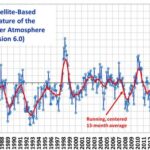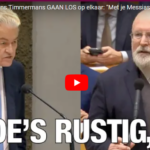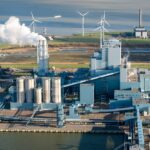In een voordracht in 2014 verklaarde de Duitse Vice-Bondskanselier, Sigmar Gabriël:
Die Energiewende steht kurz vor dem Aus. Die Wahrheit ist, dass wir die Komplexität der Energiewende auf allen Feldern unterschätzt haben. Die anderen Länder in Europa halten uns sowieso für Bekloppte.
…
Wie had gedacht dat de opmerking van Gabriël het begin van de terugkeer van gezond verstand inluidde, had het mis.
Nu, twee jaar later, lijkt er toch licht te gloren aan het eind van de tunnel en zal er binnenkort een Plan B in werking treden.
Onder de titel (Engelse vertaling), ‘German Government ‘Plans To Stop And Reverse Wind Power’, schreef Frank-Thomas Wenzel in de ‘Berliner Zeitung’:
If the green energy plans by the German Federal Government are implemented, the expansion of onshore wind energy will soon come to a standstill and then go into reverse. …
What is the future of wind energy in Germany?
This depends entirely on political developments. In early March, German Economy Minister Sigmar Gabriel presented a draft for the amendment of the Renewable Energies Act (EEG). The new rules regulate the subsidy levels for renewable energy. The new regulations are to be adopted in coming months. The draft says, inter alia, that the amount of renewable energy in the electricity mix will be limited to a level of 40 to 45 percent by 2025. At the end of last year the level was already nearly 33 percent.
De groenen staan natuurlijk op hun achterste benen.
What does this mean for the expansion of wind energy?
A study by consultants ERA on behalf of the Green Party’s parliamentary group concludes that under these provisions the development of wind energy will collapse fairly soon: A target of 45 percent would mean that only 1500 megawatts could be installed annually after 2018, according to the study. That’s less than half as the average of wind energy installed in the past five days.
How does this affect the amount of electricity produced?
The 1500 MW of new-built wind turbines would be insufficient even to replace older ones against new ones, the ERA-authors write. This means that wind generation capacity is actually shrinking. “As a consequence, there will be an economic stagnation of electricity from onshore wind energy already in the 2020s”, the study claims. From 2022 onwards, the amount of wind power will begin to shrink. With a 1,500 megawatts limit the government would undermine its own goals of a so-called expansion corridor of 2400-2600 megawatts.
What would the 40 percent cap mean?
A 40% cap for wind energy completely stop the construction of new wind farms by of 2019, according to the ERA study. Overall, this would reduce onshore wind power by almost 6000 megawatts compared to the end of 2015 – which would mean a massive slump in wind power generation by 18 terawatt hours.
What does this mean for companies that build the plants?
“The domestic market for many manufacturers collapses completely,” says Julia Verlinden, spokesperson for Energy Policy in the Green Party’s parliamentary group. “With their plan, the federal government is killing the wind companies.” This although wind energy is a cost-effective technology which can replace nuclear and coal power plants, she adds. …
“With the planned EEG amendment Sigmar Gabriel wants to set himself a monument as the wrecker of the green energy transition,” said Green Party Vice Oliver Krischer. While the rest of the world is investing in solar and wind power, Germany’s federal government is going into reverse – just at a time when renewable energy has become so cheap.
Lees verder hier.
De oorspronkelijke link naar het artikel in de ‘Berliner Zeiting’ is hier te vinden.
Oei! Het braafste jongetje van de klas gooit de kont tegen de krib. Maar beter ten halve gekeerd dan ten hele gedwaald. En wat zal dit betekenen voor de Duitse doelstelling voor de vermindering van de CO2–uitstoot met 40 % in 1920, 55% in 2030, 70% in 2040 en 80% – 95% in 2050 (alles in vergelijking met het basisjaar 1990)? En hoe zullen andere landen, zoals Nederland, daarop reageren? Zullen die doorgaan met hun heilloze beleid waar Duitsland op zijn schreden terugkeert? En wat zal dit betekenen voor het CO2-beleid van de EU?
De toekomst zal het leren.
Voor mijn eerdere bijdragen over klimaat en aanverwante zaken zie hier, hier, hier, hier en hier.






Laten we maar eens aannemen dat het bij 40% windaandeel blijft. Met de overige onderdelen duurzaam zoals hydro kom je dan zeg maar op zoiets als 60%. Is dat erg? Ik zou niet weten waarom. Een mooi aandeel. En dan zeggen we: Ach nu ja, wir haben viel Spaß zusammen gehabt, we gaan nu weer wat anders verzinnen. Rampzalig? Economie draait als een tierelier, lage werkloosheid en staatsschuld naar nul. Het blijft wachten op de grote economische ramp die maar niet wil komen.
Hydro in NL, hoe wil je dat voor elkaar krijgen?
Dit verhaal gaat over Duitsland Boels. Had je dat nog niet in de gaten?
Herman,
Maar ook Duitsland heeft een beperkte hydro-capaciteit.
Zie voordracht Hans Werner Sinn:
http://www.dagelijksestandaard.nl/2014/02/zin-en-onzin-van-de-duitse-energiewende/
Ja Hans, ook Duitsland heeft een beperkte hydro-capaciteit. Daarom tel ik bij de genoemde 40% voor wind er nog 20% zusammen voor alle overige duurzame componenten als zon, hydro, biomassa, enz enz, enz bij op. Het is een schatting. We hebben het overigens dan alleen nog maar over het aandeel in de stroomvoorziening. Waar het om gaat natuurlijk dat wij niet weten of we de wende wel kunnen volbrengen. Het kan zijn dat de ommekeer een tijdje in de ijskast moet. Is dat een ramp? Ik denk van niet.
60% schone elektriciteit is onvoldoende en betekent dat de Energiewende geen oplossing is.
Nadat die 60% behaald is (tegen hoge kosten) zal men wellicht beslissen om alsnog kernenergie toe te passen. Na die beslissing is het niet nodig om ook maar 1 zonnepaneel, windturbine, waterkrachtcentrale, of biomassacentrale te bouwen. Ze zullen allemaal weer uit bedrijf genomen worden. Kernenergie zorgt dan zelfstandig (veel later dan nodig) voor de duurzame energievoorziening van Duitsland. De periode van de Energiewende zal de geschiedenis ingaan als kostbare en tijdverspillende blunder.
Wie weet Joris. Maar er zijn nog wel meer scenario’s mogelijk. We kunnen niet alles exact alles van te voren voorspellen. De techniek staan ook niet stil. Waar het om gaat is dat we ondertussen viel Spaß zusammen gehabt hebben. Er is geen ramp voltrokken en dat gaat ook niet gebeuren. En de kosten….Ach….Wat een gezeur.
Volgens https://energy-charts.de/power_de.htm
mag je in de handen knijpen als hydro voor 3% van de totale energieproductie zorgt.
Maar diepe dalen genoeg om vol te laten lopen ;-)
”Economie draait als een tierelier” Alleen jammer van die grote aantallen gezinnen die afgesloten zijn van de energievoorziening omdat ze de absurd hoge kosten niet meer op kunnen brengen.
In kernenergie Frankrijk krijgen meer dan 1 miljoen fransen energie steun. Ondanks de lagere energieprijs. Is dat ook wat voor Duitsland denk je?
In NL krijgen alle 7,5 miljoen zelfstandige huishoudens een energiebelastingvermindering van €375 per jaar.
Inderdaad. Het idee er achter is dat iedereen gebruik kan maken van een minimale hoeveelheid energie die nodig is om zeg maar in leven te kunnen blijven. Goed geregeld dus in Nederland. Zou dat wat voor Duitsland zijn? Zou dat afsluitingen voorkomen? Maar er zijn natuurlijk wel meer ‘socialistische’ systemen te verzinnen…. Voorkomt dit mooie systeem afsluitingen in Nederland? Weet jij dat Boels?
Volgens de directeur van een van de TKI Energie subgroepen gaat er in de toekomst in Nederland ook een systeem komen om de minima (extra) te beschermen tegen stijgende energiekosten. Dat was het antwoord dat ik kreeg op mijn vraag wat ze vond van het feit dat de kosten van de Energietransitie/Energieakkoord vooral bij de minima liggen terwijl de baten vooral bij de rijken en hogere middenstand terecht komen.
Oftewel: stijgende energiekosten voor Nederland door inefficient energiebeleid spelen geen rol, want we kunnen de kosten gewoon steeds opnieuw herverdelen zodat iedereen even hard geraakt wordt en iedereen dus weer blij wordt.
Slim. Heel slim.
De huidige subsidie kosten voor duurzame energie liggen momenteel op 600.000 miljoen per jaar. De huidige kosten voor hypotheekrente aftrek liggen momenteel op 12 miljard per jaar. Ik hoef niet uit te leggen dat de onderkant van de samenleving hiervan niet profiteert. Die hebben dan weer wel de huursubsidie. En zo kunnen we naar hartelust selectief winkelen in het oneigenlijk gebruik der argumenten om de eigen ideologie kracht bij te zetten.
Hypotheekrenteaftrek/huursubsidie is vestzak/broekzak en kost de maatschappij per saldo niets. Het is het herverdelen van welvaart, niet het vernietigen van welvaart.
Het importeren van dure windturbines en biomassa, en het afdwingen van inefficiënte activiteiten door ‘duurzame’ maatregelen met een slechte kosten/baten verhouding verplicht te stellen jaagt de maatschappij op echte kosten die de welvaart echt schaden.
Sowieso: het argument dat we ’toch al’ veel geld verkwisten en dat nog meer geld verkwisten ‘dus’ acceptabel is, is van een betreurenswaardige slapheid die ik niet van je gewend ben Herman.
Mensen die op die manier denken mogen wat mij betreft stilletjes thuis op de bank zitten en hun mening voor zich houden. Ik ben namelijk niet geïnteresseerd in hun cynische defaitisme. Maar dat kan aan mij liggen natuurlijk.
Wat een kletsverhaal Joris. Onzin. Lariekoek. De hypotheekrenteaftrek drukt natuurlijk zwaar op de begroting. 12 miljard aan belasting die niet wordt ontvangen. Niet voor niets dat alle economen hier jaren voor gewaarschuwd hebben. En niet voor niets dat hier nu wat aan gedaan wordt om dit af te bouwen.
Vrugginks reactie klopt niet. Die economen waarschuwen hoofdzakelijk tegen de grote hypotheekschulden van de Nederlanders. Er hoeft maar een tsunami, klimaatramp, kernramp, ernstige economische teruggang plaats te vinden en de persoonlijke, hypothecaire schulden worden “onhoudbaar”.
Als je wilt wonen zonder 5 jaar of meer te wachten op het beschikbaar komen van een huurwoning dan ben je veroordeeld tot het kopen van een woning.
Bij de hypotheekaftrek mag je best de opbrengst van de grondspeculatie van gemeenten betrekken (veel gemeenten vallen om als er geen financiële trucs worden uitgehaald).
Het vermogen van de huidige woningcorporaties is een kadootje van de staat.
Als je een koopwoning ziet als oudedagsvoorziening dan is hypotheekaftrek zo gek nog niet, immers over andere oudedagsvoorzieningen betaal je achteraf belasting.
Economen waarschuwen om meerdere redenen tegen de uit de hand gelopen hypotheekrente aftrek. Daar en tegen waarschuwen maar heel weinig economen tegen duurzame energie. Het feit is dat de hypotheekrente aftrek voor 10 -12 miljard belastingderving zorgt. En wat een mooie illustratie is dit weer dat de ideologie maatgevend is welke rekenregels er gevolgd worden. Iedereen jankt hier om de kosten van duurzame energie. Maar 12 miljard kosten per jaar voor de hypotheekrente aftrek is dan doodnormaal en dat noemen wij dan welvaartsverdeling. En de grap is dat de mensen dat ook echt geloven. Wat een giller. Hilarisch gewoon. Waarheid bestaat niet meer. Slechts geloof en idelogie.
Geen enkele econoom beweert dat de hypotheerenteaftrek geen herverdelingsmaatregel is. Daarentegen, elke econoom is het er over eens dat de import van windturbines en biomassa – zijnde veel duurder dan beschikbare alternatieven – welvaartschade oplevert.
De lariekoek hier komt van Vruggink.
Hypotheekrenteaftrek drukt niet op de begroting. Hooguit is het een zinloos rondpompen van geld tussen burger en staat waardoor de begroting groter is dan nodig. Maar er gaat geen stuiver van dat geld verloren. Alles blijft in Nederland.
Weet je wat we doen Joris? we maken er een spelletje van. Het spelletje heet : Wat zeggen economen over duurzame energie. Jij mag beginnen. Elke link die je levert dat economen negatief zijn (c.q. waarschuwen) over duurzame energie krijg je een punt. Elke link dat ik lever waar economen zich positief uitlaten over duurzame economie krijg ik een punt. Jij mag beginnen.
Het idee dat elke link evenveel waard is, vind ik al zo’n stuitende gedachte dat ik je dit spelletje graag alleen laat spelen. Leef je uit, zou ik zeggen.
Joris,
Jij denkt dat je over je eigen geld kunt beschikken, maar dat is een misverstand. In principe behoort alles wat jij verdient toe aan de Staat. Die doet daar allerlei prachtige dingen mee, zoals het financieren van windmolentjes op zee, het subsidiëren van zonnepaneeltjes op het dak en talloos andere Zeer Nuttige Zaken. Hypotheekrenteaftrek is dus Stelen van de Staat, en we hebben nu eenmaal met elkaar afgesproken dat alleen de Staat het monopolie op diefstal heeft.
Nu ja zeg Joris, voordat er maar een linkje ingebracht is ga je al twisten over de kwaliteit? En natuurlijk tellen wij niet linkjes maar tellen wij economen.
Voorbeeld:
http://www.transitiontowns.nl/nieuws/rifkin-over-decentrale-en-duurzame-energierevolutie/
econoom: Jeremy Rifkin.
1 – 0 voor Herman. Herman wint door opgave van Joris.
Eentje dan. CE Delft.
http://www.ce.nl/art/uploads/file/3560_Uitgebreide%20samenvatting%20visie%20HE_nieuw.pdf
Rifkin telt niet vanwege een lange geschiedenis van misleiding en misrepresentatie. Zelfs de mensen die Rifkin zelf aanhaalt in zijn boeken ter ondersteuning van zijn gedachtekronkels verklaren Rifkin voor gek. Zie bijvoorbeeld: http://esr.ibiblio.org/?p=5558
1-0 voor de waarheid.
Ed, ik beschouw belasting niet als diefstal. Integendeel, ik beschouw belasting als een van de verschillen tussen beschaving en barbarij. Ik betaal graag belasting omdat ik waarde hecht aan de zaken die dankzij mijn belasting gerealiseerd kunnen worden aan publieke diensten. Ik accepteer dat niet al het belastinggeld efficient besteedt wordt. Maar het feit dat niet al het belastinggeld altijd efficient besteedt wordt beschouw ik niet als reden om ‘dus’ maar nog meer (belasting)geld verkeerd te besteden. Belastinggeld is zo mogelijk een van de meeste waardevolle middelen die een maatschappij bezit, en het moet dus ook als zodanig beschouwd en besteedt worden. Niet verspild, en zeker niet aan import van nutteloze goederen die geen bijdrage leveren aan de welvaart van Nederland. Wat zonnepanelen en windturbines betreft zou ik nog iets kunnen zien in het subsidieren van windturbine- of zonnepanelen fabrieken *in Nederland* voor productie van deze goederen *voor Nederland*, maar het subsidiëren van de *consumptie* en dus de *import* van deze goederen – nota bene uit landen waar sociale- en milieuregels die wij zelf hanteren met de voeten getreden worden – slaat helemaal nergens op. Dit is gewoon schadelijk. Deze schade vergelijken met de hypotheekrenteaftrek is onzinnig.
Goh Joris, je denkt dus zowel speler als scheidsrechter te kunnen zijn. Maar het geeft niet hoor. Ik laat ogenblikkelijk mijn ingebrachte econoom vallen en schakel over op jou ingebrachte document. Met zelfs drie namen… Dat alleen de eerste een echte econoom is val ik niet over hoor. Het staat nu 3-0 voor mij!! Want helemaal nergens is te vinden dat deze economen negatief zijn over duurzame energie! Kan ook niet anders, het is een document van CEDelft, het groene bolwerk…
Hier krijg ik haast de slappe lach van. Dit is zo grappig :)
CE Delft geeft aan dat er maar liefst 2 miljard extra nodig is, per jaar, om de in dit rapport onderzochte (kleine) duurzaamheidswinst te financieren.
Hoe interpreteer jij dat als zijnde goed voor de maatschappij?
CE Delft zegt in het rapport nergens dat hogere energiekosten goed zijn voor de maatschappij.
Juist omdat CE Delft een groen bolwerk is, zou hun conclusie dat (niet-nucleaire) duurzaamheid de maatschappij gewoon geld kost indruk moeten maken.
Jij kan slechts groene beroepsverwarringzaaier Rifkin in stelling brengen om je bizarre ideeen te onderbouwen. Verder is er niemand te vinden.
3-0 voor de waarheid.
Joris, De vraag was welke economen waarschuwen voor duurzame energie. De vraag is NIET of hogere energiekosten goed zijn voor de maatschappij. Dat is wat jij er nu opeens van tracht te maken. Het lijkt mij duidelijk Joris dat je er probeert tussenuit te draaien. Duurzame energie vraagt investeringen dat weet iedereen. Zelfs een Pier Vellinga heeft het over 10 miljard per jaar. De vraag is in welke mate dit een gevaar is voor onze maatschappij, onze welvaart. Behalve Hans Labohm die als alarmist de grote ineenstorting predikt ken ik namelijk geen economen die ons waarschuwen voor grote rampspoed t.g.v. duurzame energie. Ze zijn er vast wel, ik schat (gok) maar zo 3% van de economen die dat doet. Je zou ze te eten moeten geven….. Maar ik schat dat 97% van de economen dat helemaal niet doet. Integendeel. Zoiets als 97% van alle klimaatwetenschappers…. weet je nog wel? Waarom geloof je die wel blind Joris?
Mijn reactie hieronder.
Onzin Vruggink. 2 miljard per jaar extra kosten = welvaartschade. Punt. Dat hoeft niemand er expliciet bij te zeggen, want het is zo klaar als een klontje.
Hooguit kun je zeggen dat die 2 miljard ‘niet uit maakt’. (en zoiets heb ik je inderdaad wel vaker zijn schrijven). Daarmee geef je dan slechts aan dat je een verwende elitaire egoist bent die het geen reet interesseert dat de medemens nodeloos op kosten gejaagd wordt. Ik denk dan aan iemand als Richard Tol, met zijn ongelooflijke opmerking over waarom hij zich geen zorgen maakt over klimaatverandering:
“We just established that climate change is primarily a problem of the poor, right? I am not poor and I’ll make sure that my children aren’t poor either.”
http://www.carbonbrief.org/in-conversation-roger-harrabin-and-richard-tol
Wat Vruggink eigenlijk zegt is: “Die 2 miljard per jaar is niet mijn probleem, want ik ben niet arm, en ik zal zorgen dat mijn kinderen ook niet arm zijn.”
Of is het meer iets van: “Ik heb zonnepanelen of aandelen in een windpark, dus die 2 miljard betaal ik niet aan mee. Sterker nog: Ik wordt nu juist betaald uit die 2 miljard, dus die 2 miljard moet blijven. Zo lang mogelijk. Dus probeer ik die 2 miljard te verdoezelen en er verwarring over te scheppen.”
Leg uit Vruggink: Wat is jouw persoonlijke belang bij hoge energiekosten in Nederland?
Tja, Joris JIJ kan wel roepen vanuit je ideologie dat duurzame kosten automatisch welvaart schade is, maar de vraag is en was welke econoom dat roept….
En Richard Tol is nu de eerste waar je mee aankomst die serieus kritisch is. Puntje voor Joris. Het staat nu 3 – 1 voor Herman.
Tja, die 2 miljard per jaar, daar blijft het natuurlijk niet bij, dat worden er wel minstens 10 miljard per jaar. Ongeveer gelijk aan de kosten van hypotheek rente aftrek. Oh wacht… dan noemen wij het welvaartsherverdeling… wat een giller. Dat gejank om die kosten doen je maar in verkiezingstijd. Er is vast een 30% van het electoraat waar je boodschap als zoete koek geslikt wordt…..succes bij je verkiezingen in 2017.
Volgens Vruggink is een miljard besteedt aan hypotheekrenteaftrek hetzelfde als een miljard besteedt aan de subsidie van geïmporteerde dure energie. Flagrante lariekoek dus. Hou het maar bij de klimaatwetenschap Vruggink. Daar ben je goed in. :)
Voor de rijksbegroting is een miljard een miljard. Inkomsten en uitgaven. huursubsidie en hypotheekrenteaftrek staan aan de kostenkant, overdrachtbelasting en eigenwoning forfait aan de inkomsten kant. JA, voor mij is een miljard een miljard. Er staat een plusje of een minnetje voor. Ik ken geen derde kolom. Indien we de hypotheekrenteaftrek flink verhogen en we doen niets aan de inkomstenkant of schrappen andere uitgaven dan ontstaat er een gat op de begroting. Verhogen wij subsidies en er verandert verder niets dan valt er ook een gat in de begroting. Afhankelijk van welk heilig geloof je aanhangt noemen mensen die uitgaven slechts ‘positieve investering’ of ‘herverdeling van welvaart’. Subsidies komen in de zakken van de molenaars: herverdeling dus. Ik heb ook een geloof: Ik geloof dat een miljard een miljard is.
Het verhogen van de hypotheekrente aftrek zorgt dat er meer geld naar de burger vloeit. Het resulterende gat in de begroting is even groot als de winst voor de burger. Vestzak broekzak dus. Een verhoging van bijvoorbeeld 10 miljard kan gewoon gecompenseerd worden door 10 miljard meer belasting te heffen. Burger merkt daarvan dan alleen het herverdelingseffect. De burger hoeft niet harder te werken om zijn koopkracht op peil te houden. Rondpompen van geld dus.
Het verhogen van de subsidie voor dure, geïmporteerde energie zorgt dat er meer geld uit Nederland wegvloeit naar het buitenland. Het resulterende gat in de begroting is dus niet gecompenseerd door winst van de burger. De burger moet dus harder werken zodat hij meer belasting kan afdragen om het gat te vullen. Dat gaat ten koste van bestedingen aan andere dingen zoals cultuur, zorg, onderwijs, etc.
Ik ben niet onder de indruk van je strategie om je lariekoek maar zo vaak mogelijk te herhalen Vruggink. Misschien ben je vergeten dat ik ingenieur ben. Ik kan rekenen. Ik ben niet vatbaar voor lariekoek. Nu niet. Morgen niet. Nooit niet.
Ik proef in je pogingen om een steekhoudende argumentatie te formuleren trouwens dezelfde rotte smaak van misleiding die ook in die lariekoekstudie van CE Delft destijds geïntroduceerd werd, namelijk dat de energiebelastingsvrijstelling voor energie die energieintensieve bedrijven in Nederland genieten hetzelfde soort kostenpost voor de maatschappij is als de subsidie die wind en zonne-energie krijgen. Men concludeert vervolgens dat deze ‘subsidie’ voor fossiele energie ‘verschoven kan worden naar duurzame energie’ en dat dit ‘budgetneutraal’ zou zijn.
Geen wonder dat zoveel mensen het vertrouwen in de klimaatwetenschap en duurzaamheid verloren hebben. Wanneer mensen zoals jij en CE Delft zo opzichtig de boel belazeren dat zelfs een kind begrijpt dat hier sprake van misleiding is, ligt het in de lijn der verwachting dat mensen in opstand komen tegen de wetenschap. De schade van dit in opstand komen tegen de wetenschap is niet te overzien.
.Jij tracht mij in een CE kamp te stoppen, Joris. Nee, ik heb mijn eigen geloof . En dat geloof zegt dat een miljard een miljard is. En verder neem ik populistisch feiten vrij gejank bij zowel de grijzen als de groenen waar.
Geef gewoon toe dat een miljard aan energiekostenverhoging (nota bene in combinatie met verslechtering van de handelsbalans) wezenlijk verschilt van een miljard aan hypotheekrenteaftrekverhoging. Het ene is herverdeling van welvaart. Het andere is vermindering van welvaart. Geef dat gewoon toe, of donder dat pretentieuze weegschaaltje naast je naam bij het grofvuil. Ik heb je door Vruggink. Wen er maar aan.
In jouw benadering wellicht Joris, maar voor mij is toch een miljard een miljard. En een miljard hypotheekaftrek is op de rijksbegroting toch echt evenveel dan een miljard subsidie. Ik heb je dat al eerder uitgelegd. Wat wil je nog meer horen?
Verzet tegen Klimaatwet door werkgevers en werknemers
Werkgeversorgansatie VNO-NCW, MKB Nederland en vakbond FNV zijn het helemaal met elkaar eens. De Klimaatwet zoals die nu op tafel ligt, deugt niet. Dat meldt Trouw.
,,Te ambitieus en niet realistisch”, zeggen werkgevers en werknemers over de initiatiefwet die PvdA en GroenLinks in november vorig jaar presenteerden.
http://www.telegraaf.nl/binnenland/25575039/__Vakbonden_tegen_klimaatwet__.html
Tekst op de site van NCW-VNO:
https://www.vno-ncw.nl/nieuws/klimaatwet-leidt-tot-verlies-van-welvaart-en-banen%E2%80%99
Van de FNV:
https://www.fnv.nl/over-fnv/pers/persberichten/persarchief/2016/april/FNV-voor-klimaatwet-maar-paar-kanttekeningen/
De brief aan Klaver en Samson:
https://www.fnv.nl/site/nieuws/webassistent/j.kager/fnv-voor-klimaatwet-maar-heeft-paar-kanttekeningen/pdfbriefaanjesseklaverendiederiksamsoninzakefnvreactieopvoorstelklimaatwetdd22maart2016.doc.pdf
Wat is het “duurzame” wensdenken van Vruggink waard? Hoeveel “duurzame” subsidie nodig voordat het economisch sustainable wordt voor de consument.
Tja, wat is het waard Turris. Het zijn slechts voorkeuren. Als iedereen bij de verkiezingen in 2017 massaal voor kernenergie of kolen stemt hoor je mij echt niet klagen hoor. De wereld vergaat er niet door. Net zoals we van een aandeel duurzaam ook niet slechter worden. Voor en nadelen, meer niet. Vraag en aanbod. De consument wil nu in meerderheid duurzaam. Dat kan veranderen als de prijs die betaald moet worden te hoog wordt. Geen halszaak, geen reden voor paniek, populisme en propaganda.
Zelfs als het rendabel wordt is het onvoldoende om de beloofde opwarming tegen te gaan.
Dat moet wel steeds gezegd worden.
Eigenlijk ontbreekt het hier een beetje aan fantasie….
http://www.energieactueel.nl/denen-ontwikkelen-energiesysteem-toekomst/
Ach, die Denen toch ;-)
Fantasie op basis van geestverruimende middelen of op basis van een gebrek aan kennis van elementaire natuurkunde is een sprookje.
Bij gebrek aan “duurzaam” hangen ze ook ongegeneerd aan de nucleaire tepels van Zweden.
Bij toevallig overschot van “duurzaam” laten ze de Noren water oppompen; jammer dat het “duurzame” sprookje niet opgaat bij Noorse waterschaarste.
Pronken met andermans veren dus.
Wel zijn ze een topland als het om energieprijzen gaat.
Het probleem is niet een gebrek aan fatasie hier. Dat is het probleem waar juist ‘jullie’ aan lijden. :-P
Denemarken gidsland? Even beperkt als China. http://www.iea.org/Sankey/index.html#?c=Denmark&s=Balance